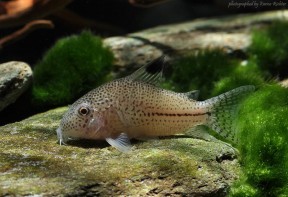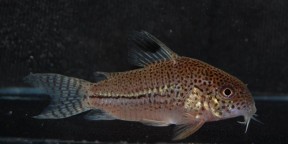Corydoras julii
Julii Cory
Etymology
Corydoras: from the Ancient Greek κόρυς (korus), meaning ‘helmet’, and δορά (dora), meaning ‘skin, hide of an animal’, in allusion to the rows of bony plates on the flanks of genus members.
julii: named in honour of a person whose identity remains a mystery.
Classification
Order: Siluriformes Family: Callichthyidae
Distribution
Native to coastal river systems south of the Amazon delta in the states of Piauí, Maranhão, Pará, and Amapá, northeastern Brazil. It has been recorded from the rios Guamá (including tributaries such as the rio Ararandeua), Maracanã (rio Peixe-Boi), Morcego, Parnaíba, Piriá, Caeté, Turiaçu (rio Jamari), and Mearim (rio Pindaré).
Reports from French Guiana and western Brazil appear to represent cases of misidentification.
Type locality is ‘Creek into River Parnaíba near Alto Parnaíba (= Victoria), 9°08’S, 45°56’W, Brazil’.
Maximum Standard Length
50 – 55 mm.
Aquarium SizeTop ↑
Minimum base dimensi0ns of 90 ∗ 30 cm or equivalent are recommended.
Maintenance
Ideally use a substrate of fine sand, although rounded gravel is an acceptable alternative provided it is kept scrupulously clean.
Other décor is largely down to personal choice, but some cover should be provided to give the fish security.
Water Conditions
Temperature: 20 – 26 °C
pH: 5.5 – 7.5
Hardness: 36 – 215 ppm
Diet
Corydoras spp. are foraging omnivores, and most will accept sinking dried foods as well as small live and frozen varieties such as chironomid larvae (bloodworm), Tubifex, etc. Feeding a varied diet will ensure the fish are in optimum condition.
Under no circumstances should they be expected to survive on ‘left-overs’ from other inhabitants of the aquarium or relied on to ‘clean’ the aquarium.
Behaviour and CompatibilityTop ↑
Peaceful and gregarious. Should be maintained in a group of at least 4-6 individuals.
Sexual Dimorphism
Females tend to grow larger, and sexually mature individuals are noticeably broader and deeper-bodied than males.
Reproduction
Can be bred in a similar fashion to many other Corydoras species.
Use a ratio of two or more males per female if possible, and when the females are visibly full of eggs perform a large (50-70%) water change with cooler water and increase oxygenation and flow in the tank. Repeat this daily until the fish spawn.
Eggs may be deposited on the aquarium glass, among fine-leaved vegetation or within sunken spawning mops, with the latter particularly recommended since they facilitate easy removal of eggs.
Once spawning is complete either adults or eggs should be removed; the latter can usually be rolled gently up the glass with a finger. The new container should contain the same water as the spawning tank and be similarly well-oxygenated.
Most breeders add a few drops of methylene blue, or an alder cone or two at this point in order to prevent the eggs developing fungus.
Incubation is normally 3-4 days and once the fry have fully-absorbed their yolk sacs they are able to accept small live foods such as microworm, Artemia nauplii, etc.
They require excellent water quality, but seem less susceptible to ailments when maintained over a thin layer of sand rather than in a bare arrangement.
NotesTop ↑
This species is also known as ‘leopard cory’ or ‘three-lined cory’ in the aquarium hobby, although many of the fish traded as C. julii are the similar-looking congener C. trilineatus. The latter is native to the upper Amazon basin, where collections for ornamental purposes are more frequent.
The two have traditionally been separated by the colour pattern on the head, with C. julii possessing numerous small, distinct spots on the head, and C. trilineatus a series of vermiform markings. However, some C. trilineatus individuals exhibit a spotted pattern, thus it can be difficult to identify these species in the absence of specific collection details.
The genus Corydoras is among the largest catfish groups and currently contains over 150 valid species. It is included in the family Callichthyidae, of which members are often referred to collectively as ‘armoured’ or ‘mailed’ catfishes group due to the presence of bony plates in place of scales on the body.
Their taxonomy can be confusing, and numerous undescribed species are also thought to exist. Fish of unconfirmed identification entering the aquarium hobby are therefore typically assigned a ‘C’ or ‘CW’ number for purposes of reference and organisation.
They are facultative air breathers and possess a modified, highly vascularised intestine which has evolved to facilitate uptake of atmospheric oxygen and aid survival in oxygen-deprived environments. In the aquarium you’ll occasionally see them rising to the surface to take in gulps of air.
The stiffened pectoral-fin spines are capable of piercing human skin and a ‘sting’ can be very painful indeed, so care should be exercised when handling them. It is thought that secretions from the axillary glands at the base of each spine may even be mildly toxic or venomous.
References
- Steindachner, F., 1906 - Anzeiger der Akademie der Wissenschaften in Wien v. 43: 478-480
Ueber zwei neue Corydoras-Arten aus dem Parnahyba und Parahimflusse im Staate Piauhy. - Reis, R. E., S. O. Kullander and C. J. Ferraris, Jr. (eds), 2003 - EDIPUCRS, Porto Alegre: i-xi + 1-729
Check list of the freshwater fishes of South and Central America. CLOFFSCA. - Espíndola, V. C., M. R. S. Spencer, L. R. Rocha and M. R. Britto, 2014 - Papéis Avulsos de Zoologia, São Paulo 54(3): 25-32
A new species of Corydoras Lacépède (Siluriformes: Callichthyidae) from the Rio Tapajós basin and its phylogenetic implications. - Ferraris, C. J., Jr., 2007 - Zootaxa 1418: 1-628
Checklist of catfishes, recent and fossil (Osteichthyes: Siluriformes), and catalogue of siluriform primary types. - Fuller, I. A. M., and H-G. Evers, 2005 - Verlag A. C. S. GmbH: 1-384
Identifying Corydoradinae Catfish. - Greven, H., T. Flasbeck and D. Passia, 2006 - Verhandlungen der Gesellschaft für Ichthyologie, Band 5: 65-69
Axillary glands in the armoured catfish Corydoras aeneus (Callichthyidae, Siluriformes). - Nijssen, H. and I. J. H. Isbrücker, 1980 - Bijdragen tot de Dierkunde 50(1): 190-220
A review of the genus Corydoras Lacépède, 1803 (Pisces, Siluriformes, Callichthyidae).










August 13th, 2014 at 3:48 pm
I kept true Julii for a short while but could never source more to raise the numbers. Eventually they succumbed to water poisoning – many thanks to my neighbours and the aerosol in the shared hallway!
99/100 the Julii labeled tank will contain Trilineatus, but question the shop keeper and some will swear that’s its correct. I’ve been in the lucky position to see side by side tanks of both species and the difference is obvious, however in smaller numbers or mixed groups its not so easy without a practiced eye.
Two reasons to ensure the label matches the fish:
1. Julii prefer it a bit warmer than the average 24c, trilineatus will take lower temps down to 22c long term. Get the mix wrong and the you could face problems, health issues, even shortened lives.
2. Having kept the side by side they do cohabit at 24c, however they will not be one big shoal. If say you have a minimum number of 6 then you may be disappointed to end up with a 3+3 with much less natural social behaviour – plus of course much less chance of breeding.
If you can find them they are nice, and slightly unusual members of the family with all the usual cory attributes of non-aggression, easy care (tho not always easy breeding!), social. Just be aware to check what you are buying!